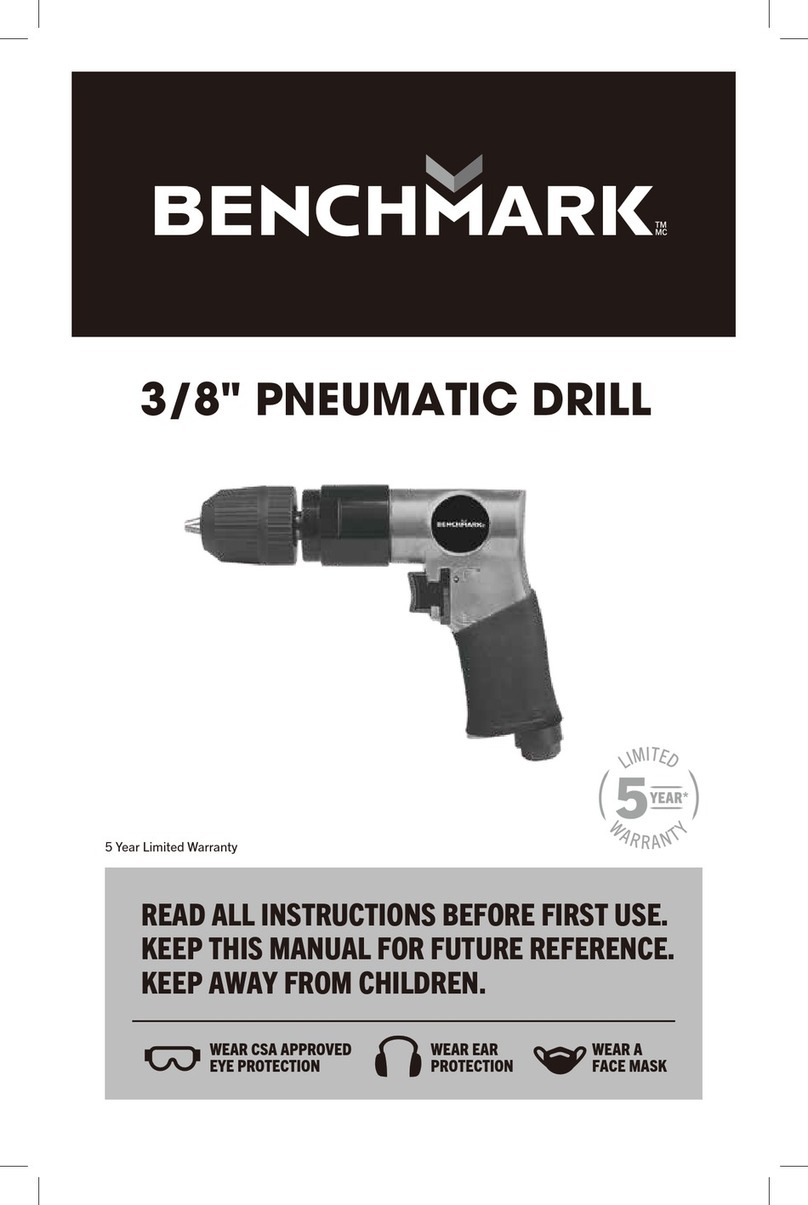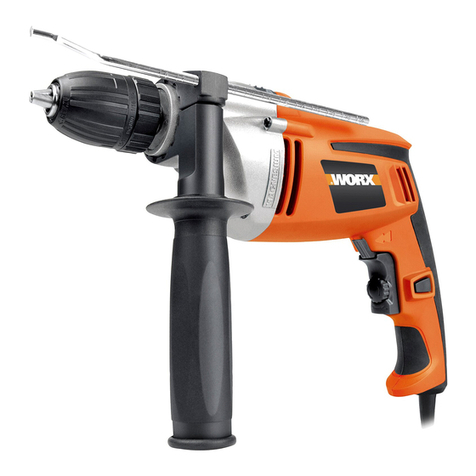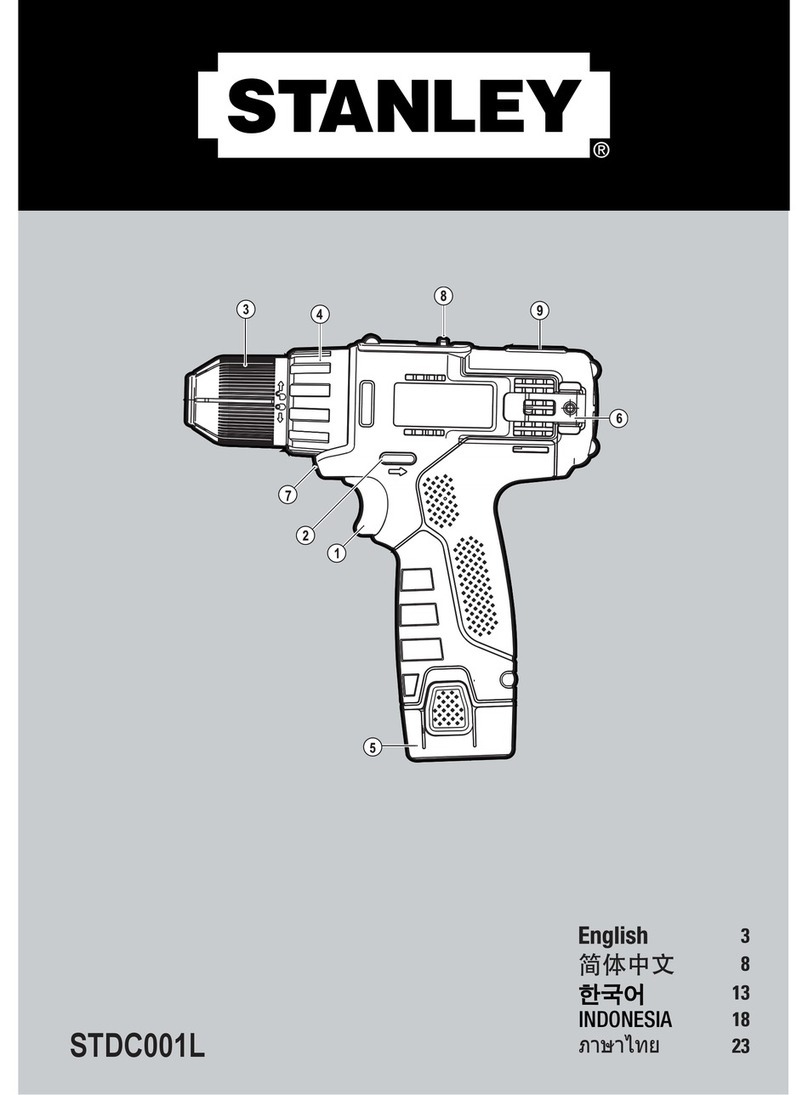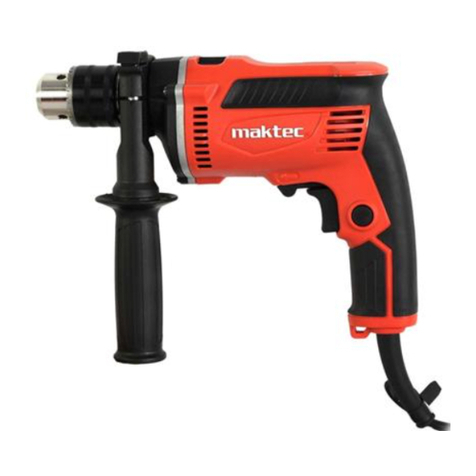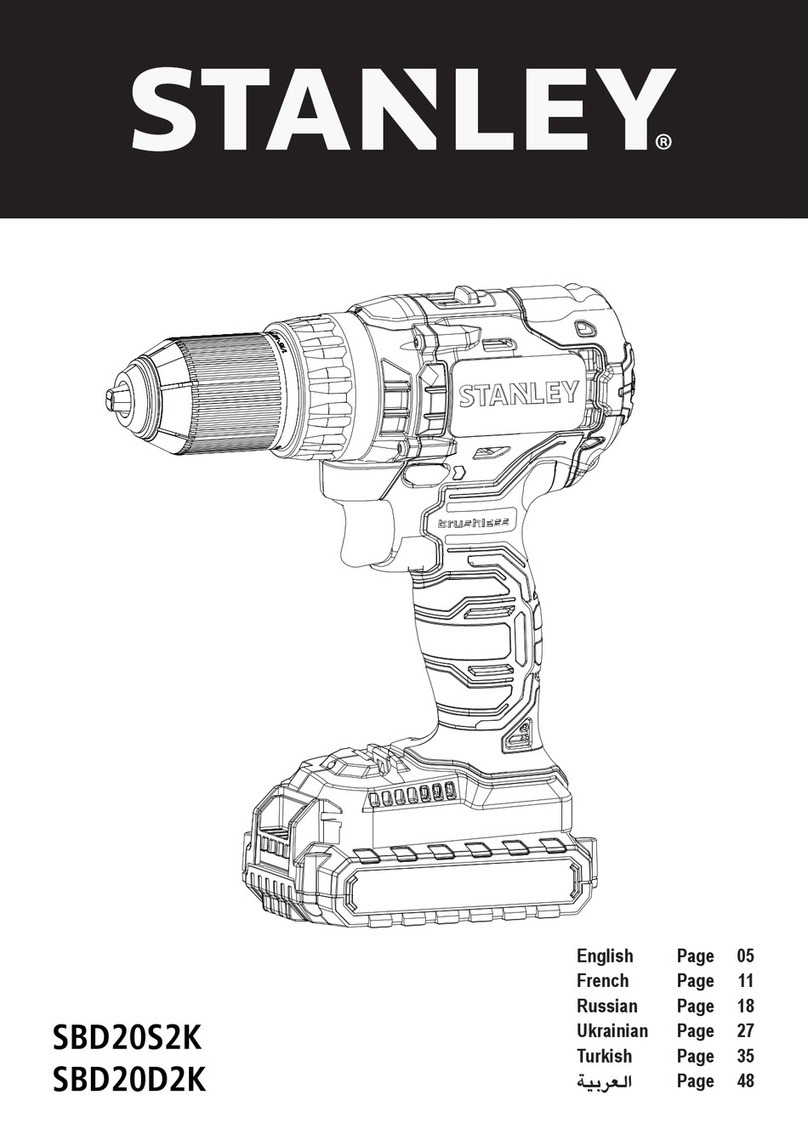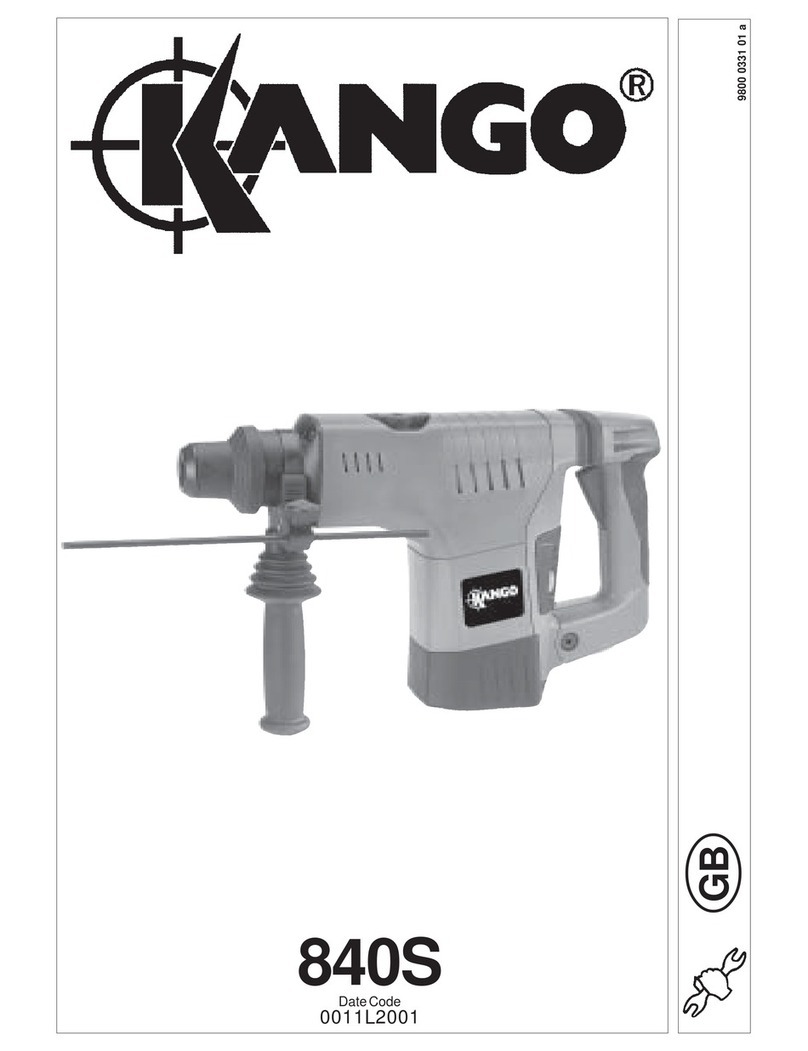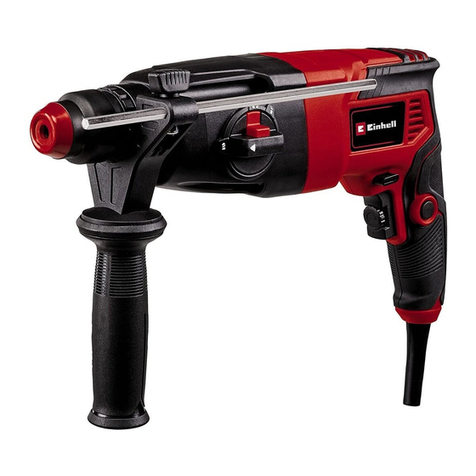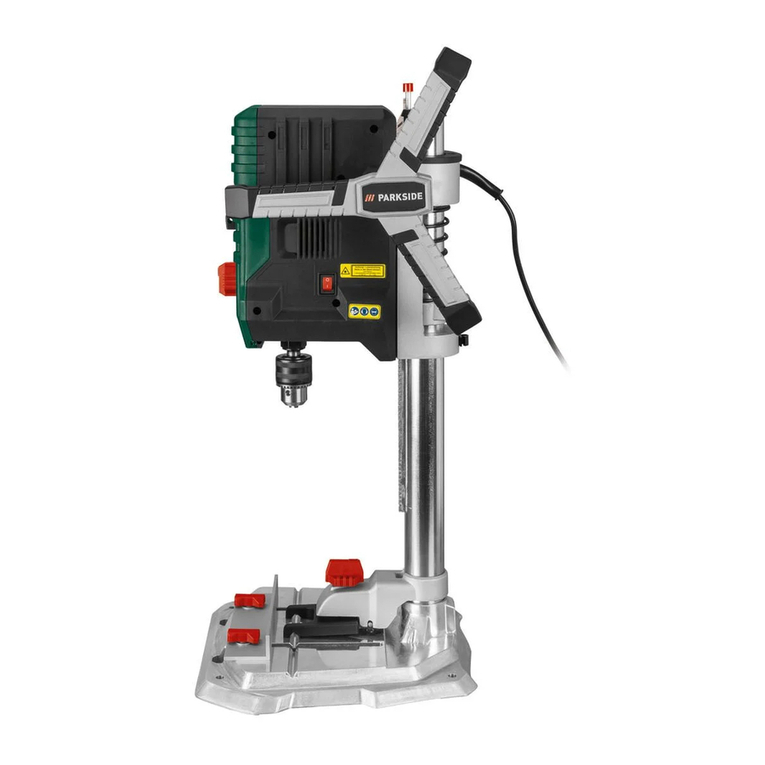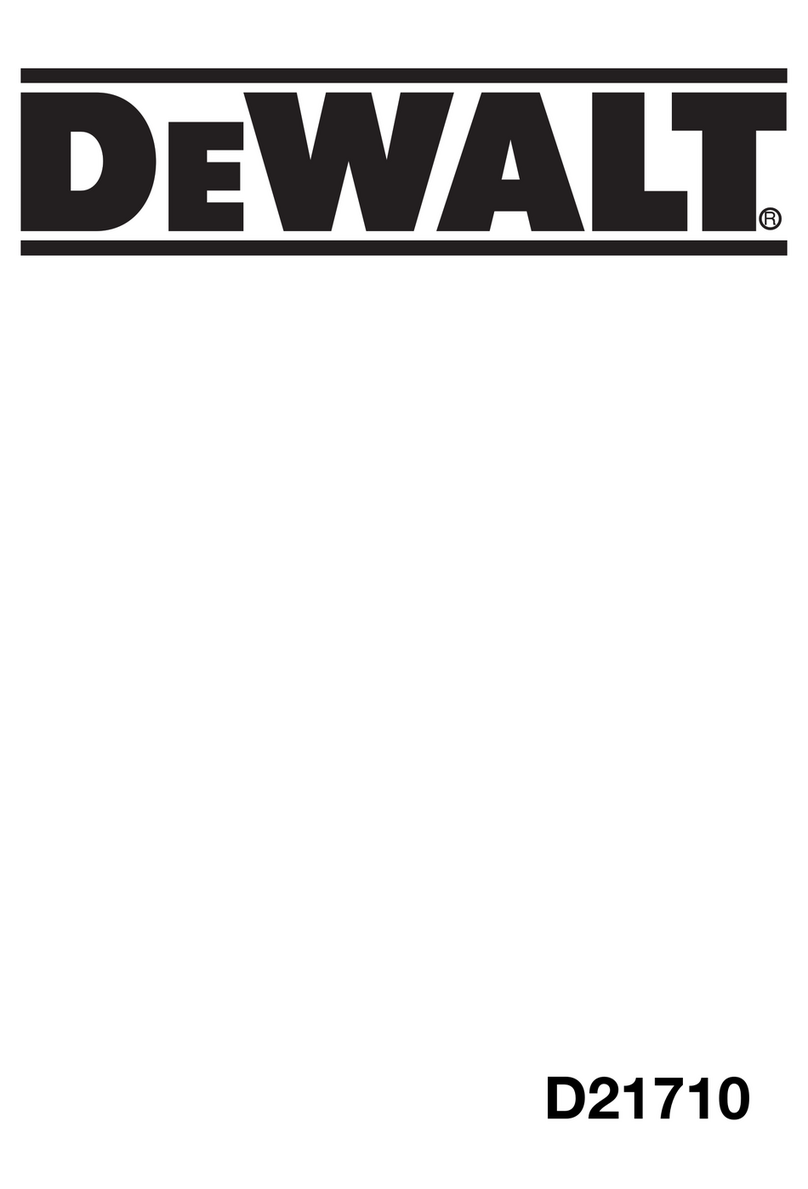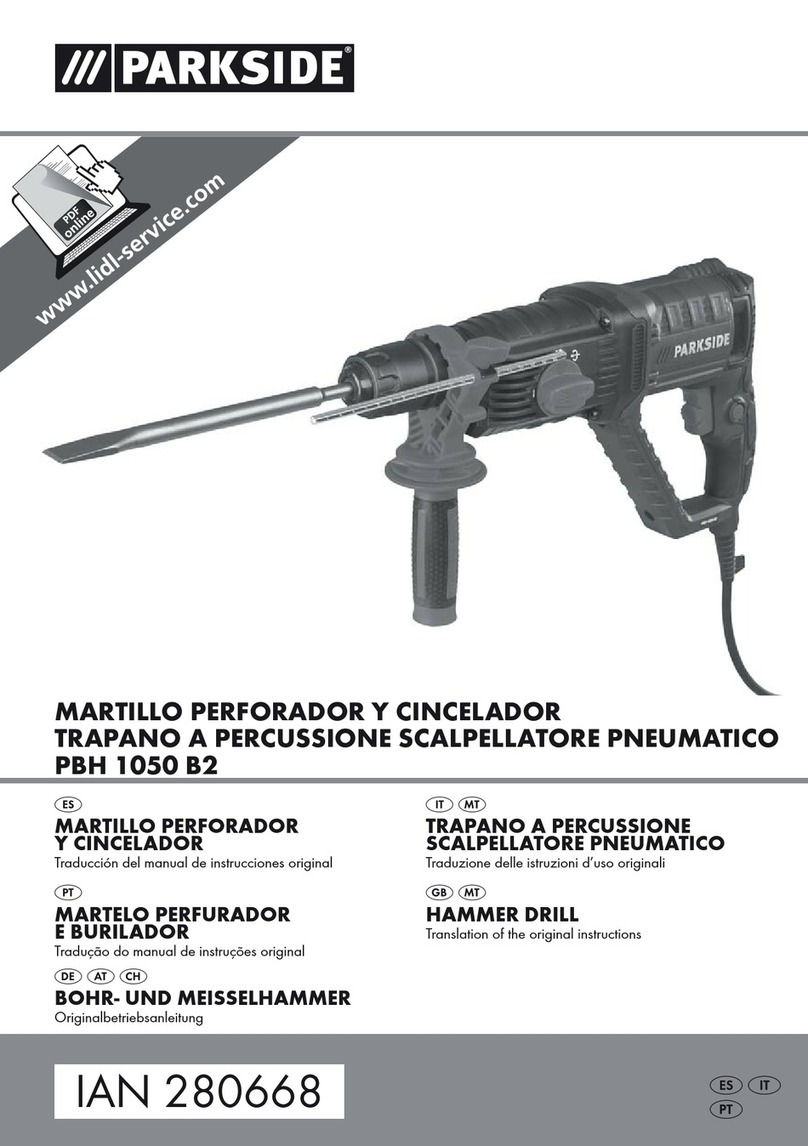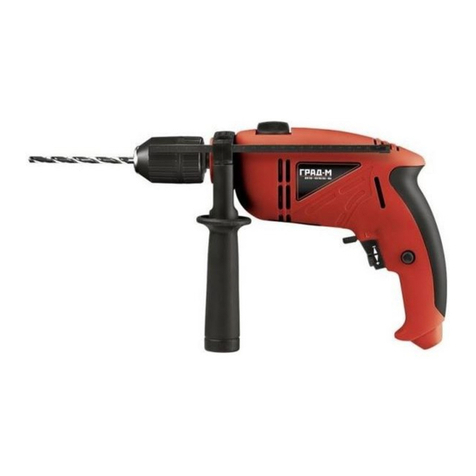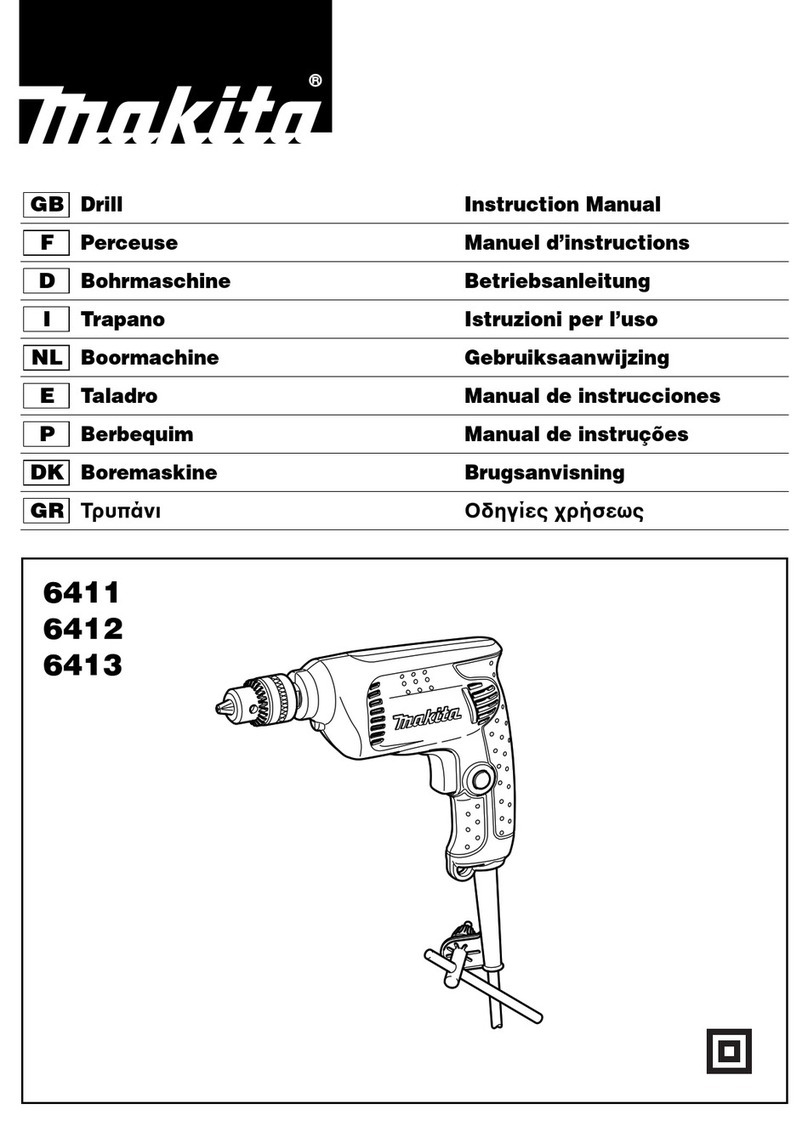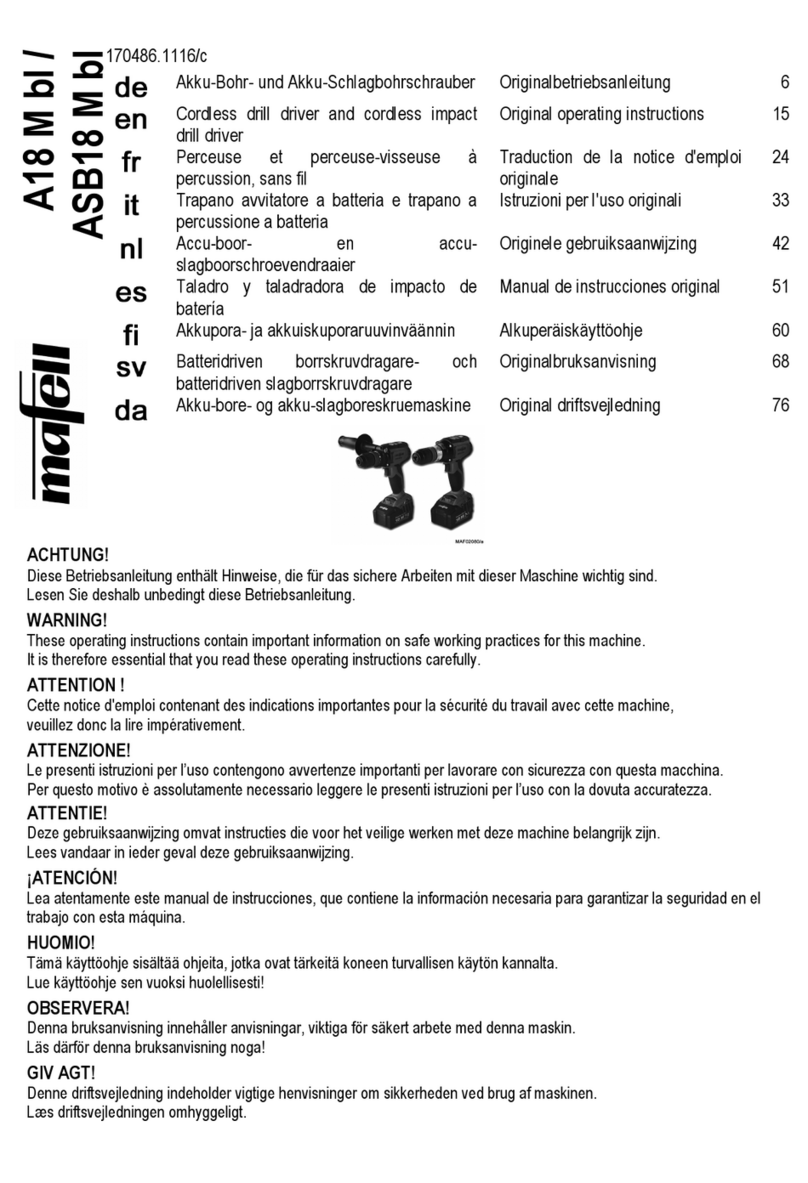Benchmark 1240-900 User manual

READ ALL INSTRUCTIONS BEFORE FIRST USE.
KEEP THIS MANUAL FOR FUTURE REFERENCE.
KEEP AWAY FROM CHILDREN.
WEAR CSA APPROVED
EYE PROTECTION
WEAR EAR
PROTECTION
WEAR A
FACE MASK
120V 60Hz
5 year limited warranty on tool
5/8" HIGH
TORQUE DRILL

1
PRODUCT SPECIFICATIONS
BENCHMARK DUAL VOLTAGE INVERTER STICK WELDER
Rating 120V, 60Hz, AC
Amperes: 10AMP
Chuck Speed: 0-750 RPM (no load)
Chuck: 5/8” Keyed
Drilling Capacity Wood 1-9/16" / Metal – 5/8"
Weight: 7.9 lbs / 3.6kg
NEED ASSISTANCE?
Call us on our toll-free customer support line:
1-866-349-8665 (Monday through Friday 9am – 5pm Eastern Standard Time)
• Technical questions
• Replacement parts
• Parts missing from package

1240-900
5/8" HIGH TORQUE DRILL
2
TABLE OF CONTENTS
Product Specifications................................................................................... 1
Table of Contents........................................................................................... 2
General Safety Warnings ................................................................................ 3
Eye, Ear & Lung Protection............................................................................. 3
Electrical Safety............................................................................................. 3
Power Tool Safety........................................................................................... 3
General Safety Rules...................................................................................... 4
Work Area...................................................................................................... 4
Electrical Safety............................................................................................. 4
Personal Safety.............................................................................................. 4
Power Tool Use and Care................................................................................ 5
Service .......................................................................................................... 5
Specific Safety Rules ..................................................................................... 7
Extension Cord Safety .................................................................................... 7
Product Specifications................................................................................... 7
Safety Symbols .............................................................................................. 8
Know your Drill............................................................................................... 9
Assembly and Operating .............................................................................. 10
Install Auxiliary Handle & D Handle .............................................................. 10
Forward/Reverse Switch............................................................................... 10
Variable-Speed Switch and Dial.................................................................... 10
Lock-On Switch ........................................................................................... 11
Installing Drill Bits........................................................................................ 11
Removing Bits.............................................................................................. 12
Drilling......................................................................................................... 12
Driving Screws............................................................................................. 13
Chuck Removal............................................................................................ 13
Retightening a Loose Chuck......................................................................... 14
Replacing Carbon Motor Brushes................................................................. 14
Maintenance ............................................................................................... 15
Exploded View ............................................................................................. 16
Parts List .................................................................................................... 17
Warranty...................................................................................................... 18

3
GENERAL SAFETY WARNINGS
WARNING:
Before using this tool or any of its accessories, read this manual and follow all Safety
Rules and Operating Instructions. The important precautions, safeguards and
instructions appearing in this manual are not meant to cover all possible situations.
It must be understood that common sense and caution are factors which cannot be
built into the product.
This instruction manual includes the following:
• General Safety Rules
• Specific Safety Rules and Symbols
• Functional Description
• Assembly
• Operation
• Maintenance
• Accessories
SYMBOL MEANING
ALWAYS WEAR EYE PROTECTION THAT CONFORMS WITH CSA
Z94.3 or ANSI SAFETY STANDARD Z87.1
FLYING DEBRIS can cause permanent eye damage. Prescription
eyeglasses ARE NOT a replacement for proper eye protection.
Non-compliant eyewear can cause serious injury if broken during
the operation of a power tool.
Use hearing protection, particularly during extended periods of
operation of the tool, or if the operation is noisy.
WEAR A DUST MASK THAT IS DESIGNED TO BE USED WHEN
OPERATING A POWER TOOL IN A DUSTY ENVIRONMENT.
Dust that is created by power sanding, sawing, grinding, drilling, and
other construction activities may contain chemicals that are known
to cause cancer, birth defects, or other genetic abnormalities. These
chemicals include:
Lead from lead-based paints Crystalline silica from bricks, cement,
and other masonry products Arsenic and chromium from chemically
treated lumber The level of risk from exposure to these chemicals
varies, according to how often this type of work is performed. In order
to reduce exposure to these chemicals, work in a well-ventilated area,
and use approved safety equipment, such as a dust mask that is
specifically designed to filter out microscopic particles.
To avoid electrical hazards, fire hazards or damage to the tool,
use proper circuit protection.
This tool is wired at the factory for 120 Volts AC operation. It must be
connected to a 120 Volts AC, 15 Amps circuit that is protected by a
time-delayed fuse or circuit breaker. To avoid shock or fire, replace
power cord immediately if it is worn, cut or damaged in any way.

1240-900
5/8" HIGH TORQUE DRILL
4
GENERAL SAFETY RULES
WARNING: Read all safety warnings and all instructions. Failure to follow the
warnings and instructions may result in electric shock, fire and/or serious injury.
Save all warnings and instructions for future reference.
WORK AREA SAFETY
Keep work area clean and well lit. Cluttered or dark areas invite accidents.
Do not operate power tools in explosive atmospheres, such as in the presence
of flammable liquids, gases or dust. Power tools create sparks which may ignite
the dust or fumes.
Keep children and bystanders away while operating a power tool. Distractions can
cause you to lose control.
ELECTRICAL SAFETY
Power tool plugs must match the outlet. Never modify the plug in any way.
Do not use any adapter plugs with earthed (grounded) power tools. Unmodified
plugs and matching outlets will reduce risk of electric shock.
Avoid body contact with earthed or grounded surfaces such as pipes, radiators,
ranges and refrigerators. There is an increased risk of electric shock if your body is
earthed or grounded.
Do not expose power tools to rain or wet conditions. Water entering a power tool
will increase the risk of electric shock.
Do not abuse the cord. Never use the cord for carrying, pulling or unplugging
the power tool. Keep cord away from heat, oil, sharp edges or moving parts.
Damaged or entangled cords increase the risk of electric shock.
When operating a power tool outdoors, use an extension cord suitable
for outdoor use. Use of a cord suitable for outdoor use reduces the risk of
electric shock.
If operating a power tool in a damp location is unavoidable, use a residual
current device (RCD) protected supply. Use of a ground fault circuit interrupter
(GFCI) protected supply. Use of a ground fault circuit interrupter (GFCI) reduces
the risk of electric shock.
PERSONAL SAFETY
Stay alert, watch what you are doing and use common sense when operating
a power tool. Do not use a power tool while you are tired or under the influence
of drugs, alcohol, or medication. A moment of inattention while operating power
tools may result in serious personal injury.
Use personal protective equipment. Always wear eye protection. Protective
equipment such as dust mask, non-skid safety shoes, hard hat, or hearing
protection used for appropriate conditions will reduce personal injuries.
Prevent unintentional starting. Ensure the switch is in the o-position before
connecting to power source and/or battery pack, picking up or carrying the
tool. Carrying power tools with your finger on the switch or energizing power tools
that have the switch on invites accidents.

5
Remove any adjusting key or wrench before turning the power tool on.
A wrench or a key left attached to a rotating part of the power tool may result
in personal injury.
Do not overreach. Keep proper footing and balance at all times. This enables
better control of the power tool in unexpected situations.
Dress properly. Do not wear loose clothing or jewelry. Keep your hair, clothing,
and gloves away from moving parts. Loose clothes, jewelry or long hair can be
caught in moving parts.
If devices are provided for the connection of dust extraction and collection
facilities, ensure these are connected and properly used. Use of dust collection
can reduce dust-related hazards.
POWER TOOL USE AND CARE
Do not force the power tool. Use the correct power tool for your application.
The correct power tool will do the job better and safer at the rate for which it was
designed.
Do not use the power tool if the switch does not turn it on and o. Any power
tool that cannot be controlled with the switch is dangerous and must be repaired.
Disconnect the plug from the power source and/or the battery pack from the
power tool before making any adjustments, changing accessories, or storing
power tools. Such preventive safety measures reduce the risk of starting the power
tool accidentally.
Store idle power tools out of the reach of children and do not allow persons
unfamiliar with the power tool or these instructions to operate the power tool.
Power tools are dangerous in the hands of untrained users.
Maintain power tools. Check for misalignment or binding of moving parts,
breakage of parts and any other condition that may aect the power tool’s
operation. If damaged, have the power tool repaired before use. Many accidents
are caused by poorly maintained power tools.
Keep cutting tools sharp and clean. Properly maintained cutting tools with sharp
cutting edges are less likely to bind and are easier to control.
Use the power tool, accessories, and tool bits etc. in accordance with these
instructions, taking into account the working conditions and the work to be
performed. Use of the power tool for operations dierent from those intended could
result in a hazardous situation.
Hold power tools by insulated gripping surfaces when performing an operation
where cutting tool may contact hidden wiring or its own cord. Contact with a
"live" wire will make exposed metal parts of the tool "live" and shock the operator
SERVICE
Have your power tool serviced by a qualified repair person using only identical
replacement parts. This will ensure that the safety of the power tool is maintained.

1240-900
5/8" HIGH TORQUE DRILL
6
WARNING: Know your drill. Do not plug the drill into the power source until you
have read and understand this Instruction Manual. Learn the tool’s applications and
limitations, as well as the specific potential hazards related to this tool. Following
this rule will reduce the risk of electric shock, fire, or serious injury.
Always wear eye protection. Any power tool can throw foreign objects
into your eyes and cause permanent eye damage. ALWAYS wear safety
goggles (not glasses) that comply with ANSI safety standard Z87.1.
Everyday glasses have only impact resistant lenses. They ARE NOT safety
glasses.
WARNING: Glasses or goggles not in compliance with ANSI Z87.1 could
cause serious injury when they break.
WARNING: Always use a safety shield, hearing protection and dust mask when
drilling concrete.
Do not drill material too small to be securely held.
Always keep hands out of the path of the drill bit. Avoid awkward hand positions
where a sudden slip could cause your hand to move into the path of the drill bit.
Secure the workpiece. Use clamps or a vise to hold the workpiece. It is safer than
using your hand and it frees both hands to operate the tool.
Make sure there are no nails or foreign objects in the part of the workpiece
to be drilled.
Always remove the plug from the power source before installing or removing
a bit or accessory from the chuck.
Do not install or use any drill bit that exceeds 7" (17.5 cm) in length or extends more
than 6" (15 cm) beyond the chuck jaws. They can bend or break suddenly.
Always make sure the chuck is tight and the drill bit firmly tightened in the chuck
before starting drill.
Before starting the operation, jog the drill switch to make sure the drill bit does not
wobble or vibrate.
Do not use fly cutters or multiple-part hole cutters, because they can come apart or
become unbalanced during use.
Make sure the spindle has come to a complete stop before touching the chuck or
attempting to change the drill bit.

7
SPECIFIC SAFETY RULES FOR
LOW GEAR MUD MIXER
Use auxiliary handle(s), if supplied with the tool. Loss of control can cause
personal injury.
• Hold the power tool by its insulated gripping surfaces when performing an
operation where the cutting accessory may contact hidden wiring or its own
cord. Cutting accessory contacting a “live” wire may make exposed metal parts
of the power tool “live” and could give the operator an electric shock.
• Keep hands away from rotating parts.
• Do not leave the tool running. Operate the tool only when it is securely hand-held.
• Protect your hearing. Wear appropriate personal hearing protection during
use. Under some conditions and duration of use, noise from this product
may contribute to hearing loss.
WARNING: Keep the extension cord clear of the working area.
Position the cord so it will not get caught on the workpiece, tools, or any other
obstructions while you are working with the power tool.
Make sure any extension cord used with this tool is in good condition. When using
an extension cord, be sure to use one of heavy enough gauge to carry the current
the tool will draw. An undersized cord will cause a drop in line voltage resulting in
loss of power and overheating.
The table at right shows the correct size to use according to cord length and
nameplate ampere rating. If in doubt, use the next heavier gauge. The smaller the
gauge number the heavier the cord.
Be sure your extension cord is properly wired and in good condition. Always have it
repaired by a qualified electrician before using it. Protect your extension cord from
sharp objects, excessive heat and damp or wet areas.
Use a separate electrical circuit for your power tools. This circuit must not be less
than 14-gauge wire and should be protected with either a 15 A time delayed fuse
or circuit breaker.
Before connecting the power tool to the power source, make sure the switch is in
the OFF position and the power source is the same as indicated on the nameplate.
Running at lower voltage will damage the motor.
MINIMUM GAUGE (AWG)
Amperage rate Total length
More than Not more
than
25' (7.5 m) 50' (15 m) 100' (30 m) 150' (45m)
0 6 18 16 16 14
6 10 18 16 14 12
10 12 16 16 14 12
12 16 14 12 Not Applicable

1240-900
5/8" HIGH TORQUE DRILL
8
SAFETY SYMBOLS
WARNING: Some of the following symbols may appear on the drill. Study these
symbols and learn their meaning. Proper interpretation of these symbols will allow
for mor ecient and safer operation of this tool.
V Volts ₃n
~
Three-phase alternating
current with neutral
A Amperes read all documentation
Hz Hertz direct current
W Watts noNo load speed
kW Kilowatts Alternating or direct current
Microfarads Class II construction
L Litres Splash-proof construction
kg Kilograms Watertight construction
H Hours Protective grounding at
terminal, Class I tools
N/cm² Newtons per square
centimetre .../min Revolutions or reciprocations
per minute
Pa Newtons per square
centimetre Diameter
OPM Oscillation per minute 0 O position
Min Minutes Directional arrow
SSeconds Warning symbol
~or AC Alternating current Wear eye protection
₃
~
Three-phase alternating
current Wear hearing protection
This symbol designates that this tool is listed with Canadian requirements by ETL
Testing Laboratories, Inc. Conforms to UL Std. 62841-1 and 62841-2-1
Certified to CSA STD.C22.2# 62841-1 and 62841-2-1
5005389
57312-1

9
KNOW YOUR BENCHMARK
10A 5/8" LOW GEAR DRILL/MIXER
Swiveling “D”
handle
Air vents
Auxiliary handle
Air vents
Chuck
Forward/reverse
switch
Speed control dial Lock-on switch
Trigger switch

1240-900
5/8" HIGH TORQUE DRILL
10
ASSEMBLY AND OPERATING
INSTALLING AUXILIARY HANDLE AND D HANDLE
WARNING: The auxiliary handle and D handle must be installed as it will
provide additional control over the drill
during heavy drilling operations.
To install the “D” handle (2), insert the “D”
Handle (2) into the hole at the back of the drill
(1), then insert the screw (3), insert the Allen
key (4) into the screw (3), turn it CLOCKWISE
to tighten it. (Fig. 1).
To install the auxiliary handle (1), simply
thread it CLOCKWISE into the threaded
hole (2) in the top of the drill (Fig. 2).
NOTE: Never use a wrench or pliers to
tighten the assist handle into the drill.
Hand tighten only.
FORWARD/REVERSE SWITCH
The forward/reverse switch (1) is
conveniently mounted immediately above
the trigger switch on the drill handle (2)
(Fig. 3). To make the drill rotate clockwise
for drilling, push the forward/ reverse
switch to the left. To make the drill rotate counter-
clockwise, push the forward/reverse switch to the
right.
NOTES: a) Never change the position of the
forward/ reverse switch while the chuck is turning.
b) The trigger switch will NOT function with the
forward/reverse switch in the middle position or
“neutral” position.
VARIABLE SPEED TRIGGER AND DIAL
This drill is equipped with a variable- speed ON/OFF trigger switch
with speed control dial.
1. To start the drill, gently squeeze the trigger switch (3) (Fig. 4).
NOTE: The drill will turn at its slowest speed when the trigger
switch is depressed slightly. The drill will turn at its fastest speed
when the trigger switch is fully depressed.
2. To stop the drill, release the trigger switch.
NOTE: Drilling at a slow speed for an extended period may cause the switch to
overheat. If the drill gets hot, stop drilling and allow it to cool for at least 15 minutes.
Fig. 1
Fig. 4
Fig. 3
Fig. 2

11
SPEED CONTROL DIAL
This feature enables you to pre-set the tool for a desired RPM when using the
“Lock-On” button feature. The tool speed is adjusted by rotating the “speed control”
dial (4) (Fig. 4) clockwise to increase the speed and counterclockwise to decrease
the speed. Once you have set the speed you desire, when the switch is completely
depressed and the “Lock-On” button engaged, the tool speed will change to the
speed you dialed in. To Pre-set a desired RPM, pull the switch back completely and
engage the “Lock-On” button. Maintain a firm grasp on the running drill with one
hand and use your free hand to rotate the “speed control” clockwise or counter-
clockwise until the desired drill speed is reached. Then pull the switch back and
release it to disengage the “Lock-On” feature. Once you’ve dialed in the desired drill
speed, when you start the drill and engage the switch “Lock-On” button the drill will
change to the speed you set with the “speed control” dial.
LOCK-ON SWITCH
The lock-on switch is available to hold the ON/
OFF switch in the ON position during prolonged
operation of the drill. To lock the ON/OFF switch in
the ON position:
1. Squeeze the switch trigger (3) (Fig. 5). 2.While
squeezing the switch trigger, press the lock-on
button (4) into the drill handle (2).
2. While holding the lock-on button into the drill handle release the switch trigger.
The drill will continue to run.
3. To turn the drill OFF while the lock-on button is holding the trigger switch ON,
squeeze and then release the trigger.
INSTALLING DRILL BITS
WARNING: Never hold the chuck body with one hand and use the drill
power to rotate the drill body to loosen or tighten bits. Serious injury may
result.
1. Remove the drill plug from the power source.
2. Rotate the chuck collar (1) to open or close the
jaws (2) to a point where the opening is slightly
larger than the bit size you intend to use (Fig. 6).
3. Insert the bit into the chuck the full length of
the jaws. Raise the front of your drill slightly to
prevent the bit from falling out of the chuck jaws.
4 Insert the chuck key (3) into one of the three
holes in the chuck body. Rotate the chuck key clockwise until the drill bit is held
firmly in place by the chuck jaws. NOTE: Do not use a wrench on the chuck key.
You may damage the key or the chuck.
Fig. 5
Fig. 6

1240-900
5/8" HIGH TORQUE DRILL
12
WARNING: Do not insert the drill bit into the
chuck and tighten as shown in Fig. 7. The drill bit
MUST be properly inserted with all three chuck
jaws holding the bit centered in the chuck. Failure
to properly insert the drill bit could cause the drill
bit to be thrown from the chuck resulting in possible
serious injury or damage to the chuck.
REMOVING BITS
1. Remove the drill plug from the power source.
2. Insert the chuck key into one of three holes in the chuck body.
Rotate chuck key counter- clockwise until the chuck jaws release the drill bit.
NOTE: Do not use a wrench on the chuck key or you may damage the key or
chuck.
3. Remove the drill bit.
WARNING: Have you read "GENERAL SAFETY WARNINGS", "POWER
TOOL SAFETY WARNINGS", "SPECIFIC SAFETY RULES", "EXTENSION
CORD SAFETY" and "SYMBOLS" on pages 3, 4, 5, 6, 7, 8 & 9 of this
Instruction Manual? If not, please do it now before you operate this drill.
Your safety depends on it!
Every time you use the drill you should verify the following:
1. Chuck is tight.
2. Workpiece is properly secured.
3. Safety glasses are being worn.
Failure to adhere to these safety rules can greatly increase the chances of injury.
DRILLING
When drilling in smooth hard surfaces such as metal, use a center punch to mark
the desired hole location. This will prevent the drill bit from slipping o center as
the hole is started. The workpiece to be drilled should be secured in a vice or with
clamps to keep it from turning as the drill bit rotates (Fig. 8).
1. Check the drill bit to make sure it is firmly
locked into the drill chuck and the forward/
reverse switch is in the forward position.
2. Hold the drill firmly with both hands. Use your
left hand to grasp the main handle and switch
and your right hand to grasp the auxiliary
handle (Fig. 8). If the auxiliary handle cannot
be used due to inadequate space, use your
right hand to grasp the swivelling “D”
handle (Fig. 9).
3. While holding the drill firmly, place the
point of the drill bit at the point to be drilled.
Squeeze the switch trigger to start the drill.
NOTE: Always use a higher drill speed when
Fig. 7
Fig. 8

13
drilling small holes. Use a slower drill speed when
drilling large holes.
4. Move the drill bit into the workpiece applying
only enough pressure to keep the bit cutting.
Do not force the drill bit or apply sideways
pressure to elongate the hole.
WARNING: Be prepared for binding and bit
breakthrough. When these situations occur, the
drill bit has a tendency to grab the workpiece.
This action will kick the drill opposite to the
direction of the drill bit rotation and could cause
loss of control when breaking through material
as you complete drilling the hole.
If you are not prepared, this loss of control can
result in possible serious injury.
When drilling metals, use a light oil on the drill bit to keep it from overheating.
The oil will prolong the life of the drill bit and improve the drill cutting action. If the
bit jams in the workpiece or if the drill stalls, release the switch trigger immediately.
Remove the bit from the workpiece and determine the reason for jamming.
DRIVING SCREWS
When driving screws, care must be taken to use the bit that correctly fits the screw
being driven. Make sure you use the largest bit size that will properly fit into the
head of the screw.
1. Select the correct screwdriver bit for the screw being driven.
2. Fasten the screwdriver bit into the chuck, making sure the flats of the bit are
gripped by the chuck jaws.
NOTES:
a) If the material is particularly soft or porous, run the drill at slower speeds to
avoid over-driving the screw.
b) Hold the drill firmly with both hands while driving screws to avoid loss of control.
CHUCK REMOVAL
The drill chuck must be removed in order to use some accessories.
To remove the chuck:
1. Remove the drill plug from the power source.
2. Insert a 5/16" or larger hex key (1) into the chuck
(2) and tighten the chuck jaws securely. Make
sure each of the three chuck jaws (3) is seated
on the flat surfaces of the hex key (Fig. 10).
3. Tap the hex key sharply with a mallet (4) in a
CLOCKWISE direction. This action will loosen
the screw in the chuck for easy removal.
Fig. 9
Fig. 10

1240-900
5/8" HIGH TORQUE DRILL
14
4. Open the chuck jaws and remove the hex key.
5. Open the chuck jaws as far as possible.
6. Remove the chuck screw using a #2
screwdriver (Fig. 11).
NOTE: Turn screw CLOCKWISE to remove it.
This screw has a left-hand thread.
7. Insert the hex key into the chuck and tighten the jaws of the chuck securely (Fig.
12). Tap the hex key sharply with a mallet in a COUNTER-CLOCKWISE direction.
This will loosen the chuck on the spindle. The chuck can now be unscrewed and
removed from the spindle by hand.
RETIGHTENING A LOOSE CHUCK
After installing the chuck once it has been
removed, the chuck may become loose on the
spindle and develop a wobble. Also, the chuck
screw may become loose, causing the chuck
jaws to bind and prevent them from closing. To
tighten the chuck, follow these steps:
1. Insert the hex key into the chuck and tighten
the chuck securely.
2. Tap the hex key sharply with a mallet in a
CLOCKWISE direction (Fig. 12). This will
tighten the chuck on the spindle.
3. Open the chuck jaws and remove
the hex key.
4. Tighten the chuck screw using a #2 screwdriver.
NOTE: Turn the screw COUNTER- CLOCKWISE to tighten it.
This screw has a left hand thread.
REPLACING CARBON MOTOR BRUSHES
The carbon motor brushes will wear down and require replacing. The time intervals
between replacements will vary depending upon the working environment and the
hours of use. It is recommended that the brushes be checked after each 10 hours
of use. When the length of the carbon brush reaches 1/4" (6.35 mm), the brushes
should be replaced.
WARNING: Unplug the tool from the power source.
1. Use a 3/16" (5 mm) slot screwdriver and
remove one brush cap (1) (fig. 13). Turn the
brush cap counter-clockwise to remove it from
the motor housing.
2. Pull the spring & brush assembly (2) from the
brush holder (3) in the motor housing (4).
3. Insert the new spring & brush assembly into
the motor housing.
4. Compress the spring into the brush holder
and thread the brush cap back into the
motor housing.
Fig 11
Fig. 11
Fig 12
Fig. 12
Fig. 13

15
NOTE:
Make sure the brush cap threads are not cross-threaded. Do NOT over tighten.
5. Repeat steps 1 to 4 to replace the second carbon brush located on the opposite
side of the motor housing.
GENERAL MAINTENANCE
WARNING: When servicing, use only identical replacement parts. The use of
any other part may create a hazard or cause product damage.
DO NOT use solvents when cleaning plastic parts. Plastics are susceptible to
damage from various types of commercial solvents and may be damaged by their
use. Use a clean cloth to remove dirt, dust, oil, grease etc.
WARNING: Do not allow brake fluids, gasoline, petroleum-based products,
penetrating oils, etc. to come into contact with plastic parts. They contain
chemicals that can damage, weaken or destroy plastic.
DO NOT abuse power tools.
Abusive practices can damage the tool and the workpiece.
WARNING: DO NOT attempt to modify tools or create accessories. Any such
alteration or modification is misuse and could result in a hazardous condition
leading to possible serious injury. It will also void the warranty.
LUBRICATION
All of the bearings in this tool are lubricated with a sucient amount of high-grade
lubricant for the life of the unit under normal conditions. Therefore, no further
lubrication is required.

1240-900
5/8" HIGH TORQUE DRILL
16
EXPLODED VIEW

17
PARTS LIST
WARNING: When servicing, use only original equipment replacement parts.
The use of any other parts may create a safety hazard or cause damage to the
drill. Any attempt to repair or replace electrical parts on this welder may create a safety
hazard unless repairs are performed by a qualified technician. For more information, call
the Toll-free Helpline, at 1-866-349-8665; Monday - Friday: 9am to 5pm EST.
Always order by key number.
Key # Part # Part Name Quantity
1 1240-900-001 Screw M6X25 (Left) 1
2 1240-900-002 Chuck 1
3 1240-900-003 Spindle 1
4 1240-900-004 Circlip for Hole 40 1
5 1240-900-005 Dust Ring 1
6 1240-900-006 Ball Bearing 6203 1
7 1240-900-007 Screw ST5X35 4
8 1240-900-008 Gear Box 1
9 1240-900-009 Circlip for Shift 17 1
10 1240-900-010 Key 4X5X13 1
11 1240-900-011 Big Gear 1
12 1240-900-012 Circlip for Shift 14 1
13 1240-900-013 Ball Bearing 608 4
14 1240-900-014 Gearbox Cover 1
15 1240-900-015 Ball Bearing 6200 1
16 1240-900-016 Shaft Bezel 10 2
17 1240-900-017 Medium Gear 1
18 1240-900-018 Key 3X3.7X13 1
19 1240-900-019 Gear Shift 1
20 1240-900-020 Armature 1
21 1240-900-021 Screw ST5X60 2
22 1240-900-022 Wind Wring 1
23 1240-900-023 Stator 1
24 1240-900-024 Pull Reed 2
25 1240-900-025 Housing 1
26 1240-900-026 Carbon Brush 2
27 1240-900-027 Brush Holder 2
28 1240-900-028 Brush Cap 2
29 1240-900-029 Screw ST4X16 4
30 1240-900-030 Switch Pusher 1

1240-900
5/8" HIGH TORQUE DRILL
18
Key # Part # Part Name Quantity
31 1240-900-031 Switch 1
32 1240-900-032 Screw ST4X14 1
33 1240-900-033 Cord Clip 1
34 1240-900-034 Cord Sleeve 1
35 1240-900-035 Right Handle 1
36 1240-900-036 Power Cord 1
37 1240-900-037 Chuck Key 1
38 1240-900-038 Left Handle 1
39 1240-900-039 Screw ST5X18 4
40 1240-900-040 Rear Handle 1
41 1240-900-041 Screw M8X25 1
42 1240-900-042 Side Handle 1
43 1240-900-043 Inner Hex Wrench M6X120 1
WARRANTY
10A 5/8" LOW GEAR DRILL/MIXER
If this Benchmark tool fails due to a defect in material or workmanship within five
years from the date of purchase, return it to any Home Hardware store with the
original bill of sale for exchange. Three year warranty for the battery and charger.
This warranty does not include expendable parts including but not limited to blades,
brushes, belts, light bulbs.
This warranty covers defects in material or workmanship only. It does not cover
normal wear and tear, failure due to abuse/misuse, or defects caused by careless or
accidental mishandling. If this Benchmark product is used for commercial or rental
purposes, this warranty does not apply.

19
Table of contents
Other Benchmark Drill manuals
